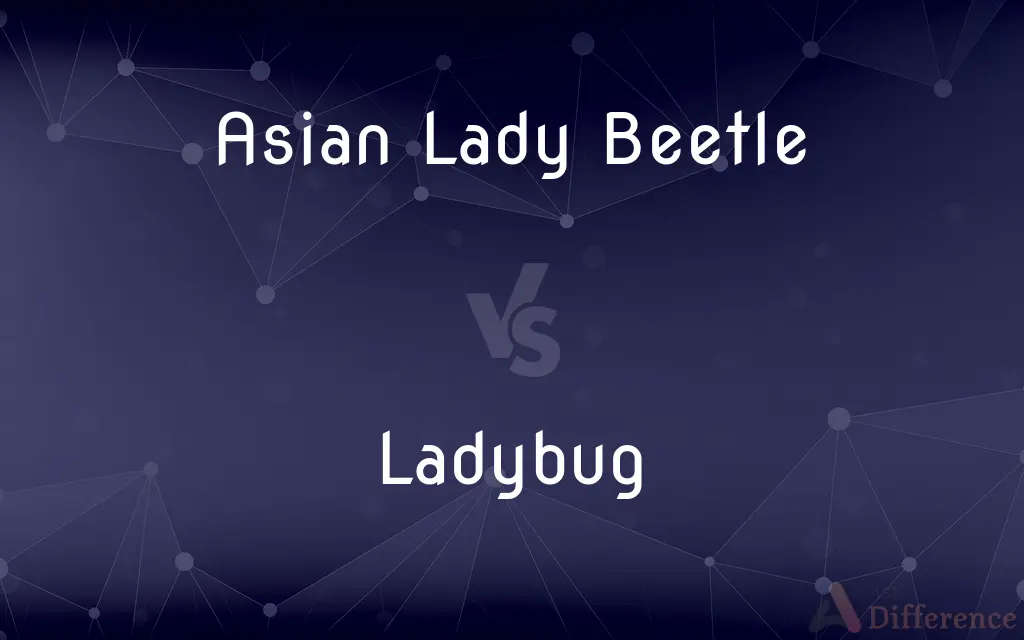Asian Lady Beetle vs. Ladybug — What's the Difference?
By Fiza Rafique & Maham Liaqat — Published on February 23, 2024
Asian Lady Beetles are often mistaken for ladybugs due to their similar appearance, but Asian Lady Beetles can be more aggressive, have a wider range of colors, and sometimes invade homes in large numbers, unlike the generally benign and beloved ladybug.

Difference Between Asian Lady Beetle and Ladybug
Table of Contents
ADVERTISEMENT
Key Differences
The Asian Lady Beetle (Harmonia axyridis) and the ladybug, or more accurately, the ladybird beetle (part of the Coccinellidae family), share a common appearance that often leads to confusion. However, several key differences set them apart. Asian Lady Beetles, introduced to North America for pest control, have a larger variety of colors, ranging from yellow to red, and possess a distinctive "M" or "W" shaped mark on their thorax. In contrast, ladybugs have a more consistent red or orange color with black spots.
One of the most notable differences is their behavior, especially during the colder months. Asian Lady Beetles are known to invade homes in large numbers to overwinter, a trait not commonly seen in native ladybugs. This invasive behavior can become a nuisance to homeowners, whereas ladybugs are less likely to infest homes and are generally welcomed for their aphid-eating habits that benefit gardens.
Asian Lady Beetles can exhibit more aggressive behavior compared to ladybugs. They might bite humans, though it's more of a pinch without serious effects, and they can secrete a yellowish fluid that leaves a stain and has an unpleasant odor when they feel threatened. Ladybugs, however, are more docile towards humans and rarely become a nuisance.
In terms of benefits, both species are considered beneficial to the environment as they consume a significant amount of aphids and other pest insects. However, the Asian Lady Beetle's aggressive nature and tendency to overwinter in homes can overshadow their benefits.
Understanding the differences between these two beetle species is important for gardeners and homeowners, especially when dealing with infestations or trying to promote biological pest control in their gardens.
ADVERTISEMENT
Comparison Chart
Color Variability
Yellow to red with varying spot patterns
Consistently red or orange with black spots
Marking on Thorax
"M" or "W" shaped mark
No distinctive mark
Behavior
Can invade homes in large numbers
Less likely to invade homes
Aggressiveness
More aggressive, may bite
Generally docile
Secretion
Can secrete a yellowish fluid that stains
Does not secrete staining fluid
Overwintering Habit
Tends to overwinter in human-made structures
Rarely overwinters in homes
Geographic Origin
Asia, introduced to North America
Native and introduced species worldwide
Pest Control Benefit
Consumes aphids and other pests
Consumes aphids and other pests
Nuisance Level
High due to invasiveness and secretion
Low
Size
Slightly larger
Smaller
Compare with Definitions
Asian Lady Beetle
Can be more aggressive and may bite if disturbed.
While gardening, she was pinched by an Asian Lady Beetle.
Ladybug
Characterized by its consistent red color and black spots.
A ladybug landed on her hand, its red shell bright against her skin.
Asian Lady Beetle
Introduced species for biological pest control.
Asian Lady Beetles were released to control aphids in crops.
Ladybug
Found worldwide, with many species native to different regions.
Ladybugs are celebrated in many cultures for their pest control.
Asian Lady Beetle
A beetle known for its wide color range and "M" shaped thorax marking.
The Asian Lady Beetle on the window sill left a yellow stain when it was startled.
Ladybug
Beneficial for gardens due to their appetite for aphids.
Ladybugs are welcomed in gardens for their pest-eating habits.
Asian Lady Beetle
Prone to invading homes in large numbers for overwintering.
In autumn, Asian Lady Beetles often swarm homes seeking warmth.
Ladybug
Same as Ladybird.
Asian Lady Beetle
Known to secrete a staining and odorous fluid as a defense.
The smell and stains on the curtains were from Asian Lady Beetles.
Ladybug
Less likely to invade homes or be a nuisance.
Unlike Asian Lady Beetles, ladybugs don't typically enter homes in the winter.
Ladybug
Generally docile and not aggressive towards humans.
The child gently held the ladybug, which calmly walked on his finger.
Ladybug
Small round bright-colored and spotted beetle that usually feeds on aphids and other insect pests
Common Curiosities
Can Asian Lady Beetles harm humans?
While they can bite, it's usually harmless and more of a pinch without long-term effects.
How can I differentiate an Asian Lady Beetle from a ladybug?
Look for the "M" or "W" shaped mark on the thorax and the wider range of colors in Asian Lady Beetles.
What should I do if Asian Lady Beetles infest my home?
Seal entry points, use a vacuum to remove beetles indoors, and consider consulting a pest control professional for severe infestations.
Why do Asian Lady Beetles invade homes?
Asian Lady Beetles seek sheltered places like homes to overwinter during cold months.
Do both Asian Lady Beetles and ladybugs eat aphids?
Yes, both species are known to consume aphids and are considered beneficial for natural pest control.
How can I attract ladybugs to my garden?
Planting flowers and herbs that attract ladybugs, such as marigolds, dandelions, and fennel, can help draw them to your garden.
Can the yellow fluid from Asian Lady Beetles stain furniture?
Yes, the yellowish secretion can stain surfaces and fabrics, so it's best to gently remove them without causing stress.
Are ladybugs beneficial to the garden?
Yes, ladybugs are highly beneficial as they consume large amounts of aphids and other garden pests.
Is it true that ladybugs bring good luck?
Many cultures consider ladybugs as symbols of good luck and prosperity, especially if one lands on you.
How long do ladybugs live?
The lifespan of a ladybug can vary, but many species live for about a year, undergoing several stages from egg to adult.
Share Your Discovery

Previous Comparison
Metals vs. Nonmetals
Next Comparison
Lyases vs. LigasesAuthor Spotlight
Written by
Fiza RafiqueFiza Rafique is a skilled content writer at AskDifference.com, where she meticulously refines and enhances written pieces. Drawing from her vast editorial expertise, Fiza ensures clarity, accuracy, and precision in every article. Passionate about language, she continually seeks to elevate the quality of content for readers worldwide.
Co-written by
Maham Liaqat















































